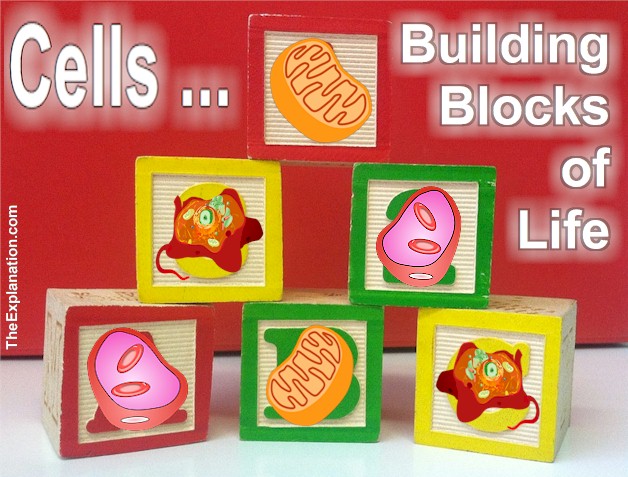Contents
Just 2 cells to start: ovum + sperm + multiplication = hundreds of different types of cells including blood cells to reach a total of 100,000,000,000,000 cells. The Building Blocks of life.

Cells … all 100 trillion (1 followed by 14 zeros) of them are the building blocks of life. They come in all shapes and sizes and fit together perfectly to form … you and I.
The average human going through his or her humdrum daily routine might think that a blood cell or any other single cell isn’t vital to a human life since we are essentially composed of 100 trillion cells, but we have had eye-opening discoveries so far.
(chapter 7.9)
Cells are the simplest form of life, and we want to explore them further, starting with blood cells. Our adult human bodies have twenty to thirty trillion blood cells that are seven microns in diameter, the width of a strand of spiderweb silk circulating in our bloodstreams.
These blood cells and our nerve, bone, and skin cells are primarily composed of oxygen, hydrogen, carbon, nitrogen, potassium, magnesium, zinc, copper, silver, gold, and many other elements, including radioactive isotopes or variants of elements from our environment, such as thorium, uranium, potassium-40, radium, carbon-14, and tritium.
These ingredients are primordial, radioactive, and toxic elements that originated before the formation of Earth.
We may think of all radioactive elements as dangerous, so it may be a surprise to discover our cells contain them. Potassium, for example, is the main radioactive element in the human body and is not harmful; in fact, it is essential for the function of all cells. This indicates how little we know or think about the elements of life.
We may think of all radioactive elements as dangerous, so it may be a surprise to discover our body cells contain them. Click To TweetWe learned about molecules, atoms, and electrons in the Big Bang chapter and water in chapter 3. Now we are examining our own relationship with these concepts.
For example, our cells contain 99 percent water molecules containing hydrogen and oxygen atoms and now we can see the hydrogen bonds between the water molecules in the cell, making the water highly cohesive so that it provides a stable environment for the chemical reactions to take place within the cell.
Since water has a high boiling point and low freezing point because of its structure, water keeps the cell’s temperature from changing too rapidly. Water preserves the cell’s health as well as its processes. For example, if the temperature of a cell drops too rapidly, those amino acids we watched at the last lab station will fail to assemble correctly to form the proteins necessary for cell function and life.
The quality and quantity of water in your body maintains temperature and cell life and all the processes needed for their reproduction. Click To TweetWe consider the qualities of water that allow the cell to carry out chemical processes and dissolve most molecules. (The exception is the lipids [fats] that make up the cell membrane.)
The process of osmosis transports water in and out of the cells via specialized motor proteins in order to maintain the balance of the constantly changing red blood cells. Osmosis is one of the many reactions and processes that take place within the red blood cell, which is just one of the four hundred varieties of human cells. We ponder all those processes within your average cell.
The red blood cell is anything but typical, as we’ll see. Inside a skin or bone cell, we see that its brain, called the nucleus, contains chromosomes, or genetic instructions, as well as proteins within the protective membrane of its nuclear envelope.
Although the instructions are similar for each cell in the same way that workers in a factory use similar directions to create products, the DNA contains different sets of instructions for blood cells than for bone cells. Similarly, your brain provides different instructions for reading than it does for operating a microscope. (We’ll explore this further in chapter 9.)
The nucleus stores DNA and transmits the genetic information. In addition, inside a region of the nucleus called the nucleolus, mRNA and tRNA are assembled for the ribosomes. The nucleus is a veritable genetic data processing center.
What else, exactly, goes on inside a cell and specifically a blood cell?
This post is an excerpt from chapter 7.9 of Inventory of the Universe.
The Explanation Blog Bonus
Just one video this week… but what a video. An absolutely must watch as you see sperm and ovum multiply over 9 months. Just sit back, listen to the soothing music and let your mind be absorbed by the incredible beauty of life being born. Yes, be amazed because surely it is wondrous … beyond imagination. I dare to ask: How do you explain it?
This second video is in slower motion with Vangelis music but it skips the first part of conception.
Dig Deeper into The Explanation
Join The Explanation Newsletter to stay informed of updates. and future events. No obligations, total privacy, unsubscribe anytime, if you want.
Online Study Courses to Unlock Bible meaning via Biblical Hebrew… with no fuss. Free video courses that put you in the driver’s seat to navigate the Bible as never before. Join now
The Explanation series of seven books. Free to read online or purchase these valuable commentaries on Genesis 1-3 from your favorite book outlet. E-book and paperback formats are available. Use this link to see the details of each book and buy from your favorite store.
Since you read all the way to here… you liked it. Please use the Social Network links just below to share this information from The Explanation, Blood Cells and All Cells – the Blocks to Build and Maintain Your Body



Trackbacks/Pingbacks